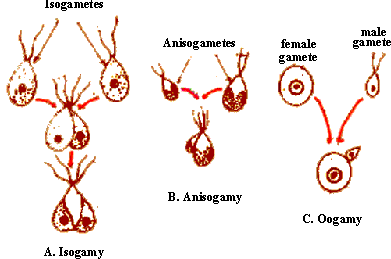|
PinkMonkey Online Study Guide-Biology
Comparison between mitosis and meiosis
|
Mitosis
-
It takes place continuously in body cells
or somatic cells.
-
The process is completed in one sequence
or phase.
-
DNA replication takes place during interphase.
-
The duration of prophase is short usually
of a few hours.
-
Homologous chromosomes do not show pairing
or synapsis.
-
Chromosomes do not show crossing over
a chiasmata.
-
Division of the centromeres or kinetochores
takes place during anaphase.
-
Each of the cells formed contains the
same number of chromosomes as in the parent cell.
-
Each diploid cell produces two diploid
cells.
-
Shuffling of chromosomes does not take
place.
-
Chromatids separate during anaphase.
-
The genetic constitution of the daughter
cells is identified to that of the parent cells.
|
Meiosis
-
It takes place during the process of
gametogenesis to form germ cells.
-
It is completed in two succesive divisions
which occur one after the other.
-
DNA replication takes place during interphase
I but not in interphase II.
-
The duration of prophase is comparatively
longer and may take days.
-
Homologous chromosomes show pairing or
synapsis.
-
Chromosomes show crossing over at chiasmata.
-
There is no division of the centromeres
during anaphase I. They divide only during anaphase II.
-
Each of the cells formed contains half
the number of chromosomes.
-
Each diploid cell produces four haploid
cells.
-
Shuffling of chromosomes takes place
resulting in different combinations of chromosomes.
-
Homologous chromosomes (not chromatids)
separate in anaphase I.
-
The genetic constitution of the daughter
cells differs from that of parent cell due to crossing
over and recombinations.
|
Syngamy
Syngamy is the fusion of two haploid nuclei or gametes.

Click here to enlarge
Figure 14.20 Syngamy
When syngamy takes place between the two identical
gametes, it is called isogamy and when it takes place between the two
dissimilar gametes, it is called anisogamy. As in higher organisms,
when it takes place between a large, passive receptive gamete called an
egg and a small active (motile) initiative gamete called sperm,
it is called oogamy.
Meiosis leads to the formation of haploid sex cells or gametes
which are individually incapable of further development. Thus, the sex
cells or gametes are arrested in their growth, but the syngamy removes
the arrest and the diploid condition is restored. The diploid zygote
formed by the union of haploid gametes is potentially capable of developing
into a new individual.
|
Table of Contents
14.0
Introduction
14.1 Kingdom
: Monera
14.2 Kingdom : Protista
14.3 Kingdom : Plantae
14.4 Kingdom : Fungi
Chapter
15
|